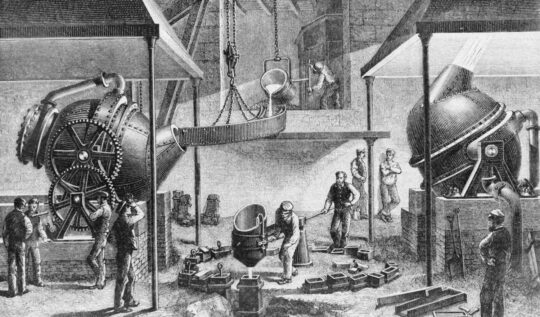Discovery of Iron: A Journey from Ancient Ages to the Modern Era
The history of iron is intricately linked with the onset of the Iron Age in the 2000s BCE. While a precise date for the initial discovery of iron cannot be pinpointed, its usage significantly surged during this period. With superior properties compared to previous metals, iron found widespread applications ranging from tools to weaponry. This discovery reshaped the technological and industrial evolution of ancient societies, catalyzing changes in their social structures. Iron, serving as a pivotal milestone in human history, pioneered cultural, economic, and military developments across eras.

Chemical Formulation and Unique Characteristics
Steel, an alloy crafted to optimize the excellent properties of iron, is typically comprised of less than 2% carbon. It is enriched with various elements such as manganese, silicon, phosphorus, sulfur, and oxygen. The carbon content critically determines the mechanical properties of steel. Low-carbon steels tend to be softer and more malleable, while high-carbon steels lean towards hardness and durability. Manganese enhances strength, particularly in structural durability. The addition of silicon can increase steel’s ductility and improve workability. Phosphorus and sulfur content impact the workability of steel, while oxygen plays a crucial role in determining steel’s resistance to corrosion. Steel manufacturers carefully control these elements to produce specialized steel types tailored for various industrial and structural needs. This complex chemical composition renders steel indispensable in various industrial sectors, turning steel production into a scientific and precise process that can develop specific steel types to meet the needs of diverse industries.

The Bessemer Process and the Impact of the Industrial Revolution on the Steel Industry
Representing a significant milestone in the history of the steel industry, the Bessemer Process emerged as an innovation influenced by the Industrial Revolution. Developed by Henry Bessemer in 1856, this process involves injecting oxygen into molten iron to reduce its carbon content. This crucial discovery fundamentally transformed the steel production process, enabling the production of purer and more economical steel. Bessemer’s scientific endeavors and engineering prowess played a catalytic role in the evolution of the steel industry. These significant developments during this period propelled the Industrial Revolution and paved the way for the widespread use of steel. Henry Bessemer’s contributions not only increased efficiency in steel production but also shaped industrial advancements, laying the foundations for the modern steel industry.
Carnegie and Schwab’s 19th Century Steel Revolution
As the steel industry grew towards the end of the 19th century, significant capitalists laid the foundations for giant companies with substantial investments in steel production. Leaders such as Andrew Carnegie and Charles Schwab are particularly renowned as pioneers of the steel industry. Under Carnegie’s leadership, the U.S. Steel Corporation became one of the largest companies of its time, valued at billions of dollars. This era not only witnessed the expansion of the steel industry but also contributed to its modernization, propelling the industry beyond its contemporary boundaries.
Contemporary Steel Production: Innovative and Sustainable Processes
Steel production is a process that takes place in modern facilities. Blast furnaces and basic oxygen furnace facilities utilize iron ore, coal, and recycled steel to produce steel. Basic oxygen furnaces stand out with their rapid charging process, ensuring effective steel production. Today’s steel industry focuses on technological innovations with an emphasis on sustainability. Modern facilities, aiming to minimize environmental impacts, concentrate on energy efficiency and emission control, achieving high-quality and sustainable steel production.
Transformation in the Construction Sector and Future Vision
Steel underwent a unique evolution in the construction sector. Initially prominent in the mid-19th century, the use of iron and steel in the construction industry became significant. Due to its high strength and flexibility, steel enhanced the durability of structures. Particularly in the early 20th century, the use of structural steel facilitated the execution of high-rise buildings, bridges, and infrastructure projects. Today, steel is considered a fundamental material in the construction sector, utilized across a broad spectrum from residences to industrial facilities. Steel stands out as a long-lasting, environmentally friendly, and economical building material. In the future, along with steel innovations, the potential to construct lighter, stronger, and more sustainable structures will likely further popularize the use of steel in the construction sector.

